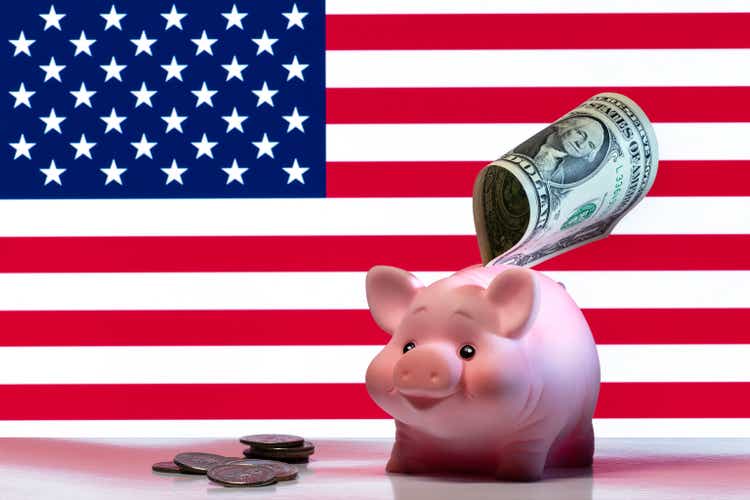Max Zolotukhin/iStock via Getty Images
“The dollar has assumed the role of the global stagflation hedge with dollar cash being one of the few financial assets offering returns,”
This is from Deutsche Bank currency strategist George Saravelow, as quoted in the Wall Street Journal.
U.S. capital flow data show the foreign cash pile of dollars is close to records as investors reduce risky assets in portfolios and hang on to the world’s reserve currency.
In other words, foreign investors are selling stocks and bonds and hoarding the cash they receive in U.S. dollars.
This evidence just supports the arguments that I have recentiy been making about the U.S. dollar.
In spite of all the other verbal battles about inflation and the economy that the Federal Reserve is facing, in terms of the value of the U.S. dollar, the Fed, over the past eight years or so, has acted in ways that have strengthened the currency in global markets.
The information on the flow of capital into the United States adds support to this argument.
Other Major Currencies
The other major currencies that have offered some challenge to the international role of the dollar in recent years…or decades…have faded out of current contention.
The Japanese yen has traditionally been a “haven” for this “risk-averse” money, but currently, the Japanese central bank is working to keep Japanese interest rates around zero.
The British pound has been another “haven” currency, but it is suffering from the failure of the Bank of England to fully engage in its fight against inflation.
Just last Thursday, the Bank of England raised its key interest rate by 25 basis points. This is the fifth such rise in recent months.
But, this is being looked on as a weak, behind-the-curve move, not sufficient to really do the job necessary. I have just written about the “weak” pound and its impact on the strength of the British economy.
Julia-Ambra Verlaine writes in the Wall Street Journal that despite the recent increases in the BOE’s key rate of interest,
“Hedge funds and asset managers said they are still selling the pound against the dollar because the central bank isn’t raising rates quickly another.”
Furthermore, the inflation rate just announced by the government indicates that the U.K. is in far more serious trouble with respect to inflation than it had been letting on.
The U.K. inflation rate reached a 40-year high of 9.0 percent in April.
Similarly, the European Union is experiencing very high rates of inflation and has not responded to the pressure in any real hurry.
Investors have been criticizing the European Central Bank for letting other central banks get ahead of them. Given all else that is happening, the ECB continues to appear as if it doesn’t really seem to have all its “ducks in line.”
Recent Action
Ms. Verlaine shows the relative performance of the major currencies this year.
The U.S. dollar has risen just under 7.5 percent.
The value of the Canadian dollar has stayed about the same this year so far.
The value of the Swiss franc has fallen by about 5.0 percent.
The Euro has fallen about 7.3 percent, while the British pound has dropped close to 7.5 percent.
And, the value of the Japanese yen has plummeted by a little more than 15.0 percent.
In terms of the performance of the price of their currency, the United States seems to be as much in charge of the situation as possible.
In terms of being the world’s primary reserve currency, the United States seems to be holding its own and doing a very good job.
The question that still remains out there, one that I write about quite often is about the role that China is going to play in terms of world reserve currencies and the challenges China raises about challenging the position of the United States and the United States dollar.
Here is my most recent post on the situation.
The Strong United States Dollar
It seems as if the United States still wants to have the number one reserve currency in the world.
The Federal Reserve, as I have recently written, seems to be doing its job to maintain this position amongst other current major currencies. It also seems to be doing a very good job in keeping ahead of China’s race to become the top dog.
But, this will be a continuing battle. It is battle United States policymakers must not let down on.
And, remember, United States policymakers must not lose focus on the fact that the reserve currency battle with the Chinese is a “long-term” battle.
The Chinese think in terms of decades. U.S. policymakers must not let down their guard in this respect because of upcoming elections. U.S. policymakers must keep their eyes on the long-run importance of having the number one reserve currency in the world. They cannot let down.
The short-term concern is that investors will look for a reversal of the rise in value of the U.S. dollar.
The dollar has had a good run-up in value this year.
Why not a decline?
Investors are looking for a reason for such a movement.
The thing is, the Fed seems to be intent on continuing to raise its policy rate of interest and to reverse the size of its securities portfolio. These are moves that will tend to keep the value of the dollar strong.
At least for the present time, this seems to be the Fed’s plan. Let’s hope the Fed sticks with that plan.


Be the first to comment